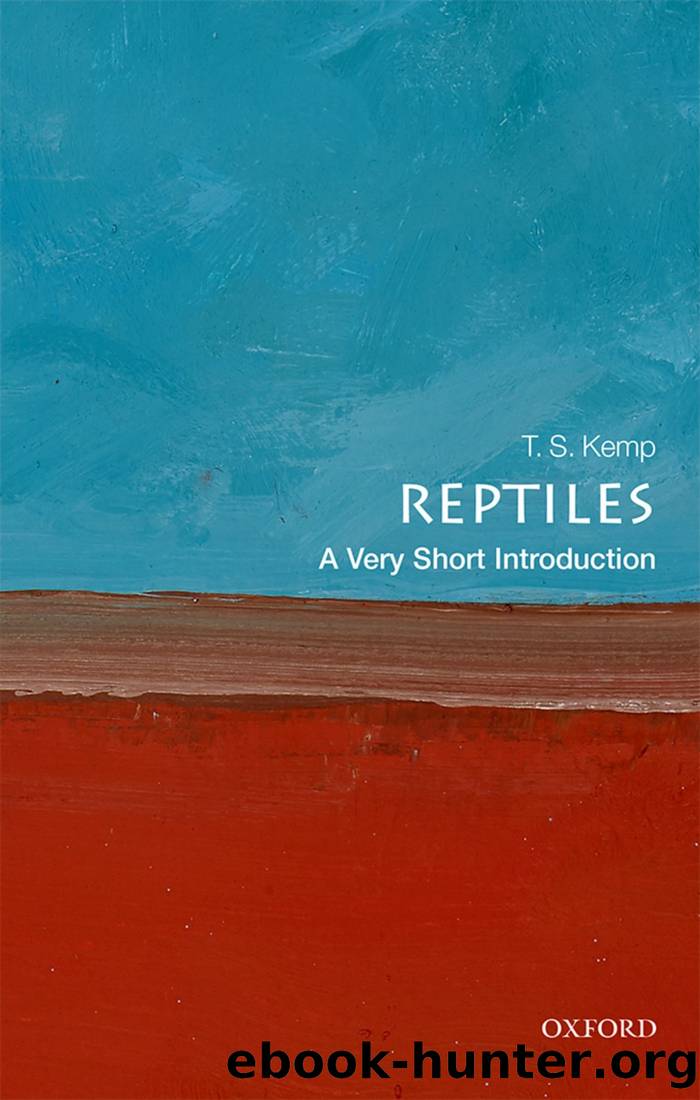Reptiles: A Very Short Introduction by T. S. Kemp

Author:T. S. Kemp [Kemp, T. S.]
Language: eng
Format: epub
ISBN: 9780192529015
Google: ixmEDwAAQBAJ
Publisher: Oxford University Press
Published: 2019-01-17T00:00:00+00:00
Chapter 4
Snakes
No group of animals has attracted more aversion and fear in people than snakes. It comes from a combination of their potentially fatal venomous bite, their creepy furtiveness as they lie in wait and appear by surprise, and the mistaken belief that they are unpleasantly cold and slimy. But from our point of view, snakes are to be admired as possibly the most superbly adapted hunting organisms in the natural world. A typical snake does not need to chase and tussle with its prey like other predators do, even though the prey itself can be so large that the snake only needs to feed once every few weeks.
The roughly 3,500 species of snakes are really a group of limbless lizards, although they are so distinctive, with so many unique features, that they are placed in their own reptile subclass, Ophidia or Serpentes. There is uncertainty about exactly where on the lizard evolutionary tree they fit. For a long time they were believed to be related to the somewhat similar limbless, burrowing worm-lizards (amphisbaenids) and blind skinks (dibamids), described in Chapter 3. But molecular evidence has shown that the similarities are actually due to independent, parallel evolution rather than to sharing a common limbless ancestor. Instead, the snakes evolved from deep within the lizard evolutionary tree, with no particularly close living relatives. The least modified of the living snakes are the blind snakes, a group given the name Scolecophidia, which means worm snakes. They are small, burrowing snakes whose eyes are greatly reduced, as their common name implies. They do not have the broad belly scales of all the more progressive snakes, and feed on small items of prey such as ants and termites. The rest of the snakes are members of the far more diverse group called Alethinophidia, which means âtrueâ snakes. These do have wide belly scales, and their skulls are specialized for feeding on large prey.
Today the snakes, like the lizards, have a worldwide distribution and occupy a great many habitats, from deserts to rain forests and seas, even including a small number of species that survive above the Arctic Circle. But it is the tropics that hold the greatest richness of diversity. Unlike lizards, snakes show very little variation in their general body form. All the living species completely lack limbs, apart from a pair of minute horny spurs alongside the cloaca in boas and pythons, a vestige of the hind limb that is used to stimulate the female in copulation. The number of vertebrae in the vertebral column is huge, 200â400. Each one attaches to the next by a strong ball-and-socket joint which allows bending, and four interlocking bony contacts to make sure they are not easily disarticulated. Snake scales are overlapping and flexible, and the single row of very wide scales along the belly found in most snakes are in contact with the ground, helping to increase the traction.
There is a certain amount of argument about how the snake ancestor lived. Most zoologists believe
Download
This site does not store any files on its server. We only index and link to content provided by other sites. Please contact the content providers to delete copyright contents if any and email us, we'll remove relevant links or contents immediately.
Sapiens: A Brief History of Humankind by Yuval Noah Harari(13053)
The Tidewater Tales by John Barth(12030)
Do No Harm Stories of Life, Death and Brain Surgery by Henry Marsh(6336)
Mastermind: How to Think Like Sherlock Holmes by Maria Konnikova(6236)
The Thirst by Nesbo Jo(5785)
Why We Sleep: Unlocking the Power of Sleep and Dreams by Matthew Walker(5642)
Sapiens by Yuval Noah Harari(4537)
Life 3.0: Being Human in the Age of Artificial Intelligence by Tegmark Max(4507)
The Longevity Diet by Valter Longo(4445)
The Rules Do Not Apply by Ariel Levy(3906)
The Immortal Life of Henrietta Lacks by Rebecca Skloot(3826)
The Body: A Guide for Occupants by Bill Bryson(3801)
Why We Sleep by Matthew Walker(3772)
Animal Frequency by Melissa Alvarez(3755)
Yoga Anatomy by Kaminoff Leslie(3701)
Barron's AP Biology by Goldberg M.S. Deborah T(3632)
The Hacking of the American Mind by Robert H. Lustig(3580)
All Creatures Great and Small by James Herriot(3516)
Yoga Anatomy by Leslie Kaminoff & Amy Matthews(3396)
